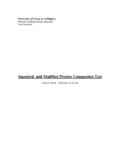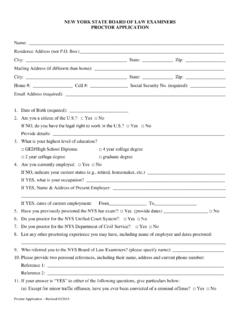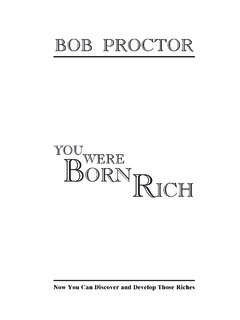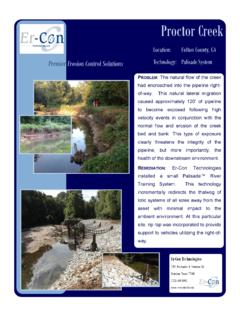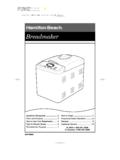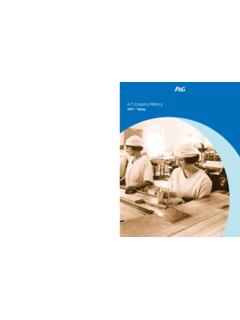Transcription of Procedure For HVAC System, Testing, Repair, And …
1 Prepared by: proctor Engineering Group, Ltd. San Rafael, CA 94901. (415) 451-2480. Procedure For hvac system , testing , Repair, And Quality Improvement Version November 15, 1994. Contributors: John proctor , Tom Downey Creators of CheckMe! LIMITED RELEASE. The enclosed forms and the procedures embodied therein are extracts of comprehensive program protocols that integrate an entire set of testing procedures with repair and post testing procedures . This comprehensive program assesses the true condition and needs of individual housing stock. It is designed to balance accuracy with production adaptability. These forms are released to you for limited use only (no more than 10 units). You are not authorized to reproduce them beyond this limited quantity either for your own use or for use by others. Additional use of these forms requires an additional written release from proctor Engineering Group (PEG).
2 Moreover, in exchange for the limited use defined above, by signing below, you agree to send copies of the completed forms to PEG. PEG has the right to analyze this data and use it for any purpose whatsoever. The intention of PEG is to learn how the forms are being used. Possession of these forms and procedures does not indicate that the bearer is competent to perform the procedures or that helshe has an understanding of the resultant information. Worker safety is not addressed in these documents and all applicable local, state, and federal laws on worker safety must be complied with. By signing below, you agree to indemnify, defend, and hold harmless proctor Engineering Group against all claims, demands, losses, damages, costs, expenses, and legal liability connected with or resulting from injury to or death of persons arising out of, related to, or in any way connected with your use of these forms and procedures .
3 Signature Date Name Company SHELL LEAKAGE testing Procedure . All appliances should pass the Combustion Appliance Safety Test Procedure prior to this test. Date _ _ _ _ _ _ _ _ Name _ _ _ _ _ _ _ _ _ _ _ _ _ _ Phone _ _ _ _ __. _____. Address City 1. Inform the homeowner of the purpose and procedures of your part of the project. Inform them that you will test the leakage of the building shell. This will require: Closing all windows and doors. Closing all fireplace or wood stove dampers. Ensuring that all exhaust devices remain off. Opening all interior doors to individual rooms. Have the customer accompany you while you perform these tasks. 2. If there are any openings that must be blocked off before the test is taken (fireplace without damper, whole house fan, etc.) record their presence in the comments and block them.
4 3. Install the blower door to pressurize the house. Zero the gages with all windows and doors closed and all exhaust devices off. 4. Adjust all combustion appliances to the pilot or off positions for the duration of the tests. 5. # of Stories Check and record building height (in # of stories) and the shielding factor for the building. Shielding 6. House Pressure Pressurize the building to 50 pa. and record the results of the single point CFM50 measurement. Do not forget to use low flow rings (to Fan Flow maintain minimum fan pressure) or wind dampening devices if Flow Ring needed. 7. Return all combustion appliances, windows and doors, dampers, and exhaust appliances to the condition in which they were found. COMMENTS. (t) 1 993 proctor Engineering Group Contact proctor Engineering Group for reproduction authorization.
5 All reproduction must carry this entire notification. This data can be rapidly analyzed by computer programs available from: proctor Engineering Group @ 818 Fifth Avenue, San Rafael, CA. 94901 (41 5) 455-5700. ver November 16, 1994. AIR CONDITIONER EFFICIENCY TEST Procedure . Use this form. for testing air conditioners when the outdoor temperature is above 70 F. AlTEMPT TO KEEP THE TEMPERATURE AT THE RETURN AIR GRILLE CLOSE TO 80 F. Date _ _ _ _ _ _ _ _ Name _ _ _ _ _ _ _ _ _ _ _ _ _ _ Phone _ _ _ _ __. Address City 1. Inform the homeowner of the purpose and procedures of your part of the project. Inform them that you will test the leakage of the duct system . This will require: Turning the air conditioner on for the tests. Making two test holes in the duct system . (They will be patched). Turning power off to the house for a short period of time.
6 2. Manf. Record the manufacturer and model number from the outside unit nameplate. Mod. 3. Capacity Look up the rated cooling capacity and EER for the Air Conditioner in the Carrier Blue Book or ARI directory. EER. 4. Capacity Convert cooling capacity to tons. Tons Capacity / 12,000 = Tonnage 5. Make holes to measure temperatures in both the supply and return systems. THIS MUST BE SOMEWHAT DISTANT FROM THE AIR. HANDLER, AS WELL AS WHERE THE AIR IS MIXED AND HAS. GOOD VELOCITY. Prepare thermocouples to measure temperatures in both locations. Do not insert the wet bulb probes yet. They will dry out. 6. Locate outdoor thermocouple to read temperature of air entering condenser 7. Locate the house meter and breaker panel. S. If it is above 75 F outside, open as many windows and doors as necessary to keep the inside temperature as close to SO F as possible.
7 9. A l _ Cfm Record the return duct leakage from the duct leakage test form. 10. Set thermostat at coolest setting. Turn on the unit and start watch to measure time. 1993 proctor Engineering Group Contact proctor Engineering Group for reproduction authorization. All reproduction must carry this entire notification. This data can be rapidly analyzed by computer programs available from: proctor Engineering Group @ 818 Fifth Avenue, Suite 208, San Rafael, CA. 94901 (415) 455-5700. ver November 16, 1994. 11. Grille #1 With the filters in and after at least ten minutes (to allow the coil to Grille #2 get wet), measure every return flow with the flow hood and record Grille #3 the results. IF system HAS A SINGLE RETURN GRILLE, DIVIDE. Grille #4 THE GRILLE AND TAKE TWO READINGS. ADD THE SUM OF. Total BOTH READINGS FOR EACH GRILLE.
8 12. Supply Measure supply and return plenum pressures. Return 13. D _SupWB. At EXACfLY 15 minutes record: The supply and return wet bulb and E _ _ Sup DB. dry bulb temperatures. Make sure the wick for the wet bulb F - - Ret WB. temperature does not dry out. G Ret DB. 14. H - - Meter Kh Turn off ALL breakers except those to the Air Conditioner and the air I -- # of rev handler. Measure watts from house meter test. J - - Seconds 15. po Record the outdoor air temperature from the outside thermometer. 16. Set thermostat back to original setting. 17. A2_ Cfm Calculate the amount of return system duct leakage at actual operating pressures using the information from step # 12 and the multiplier table (provided). 18. Calculate total system air flow. Total system air flow equals: Total Flow (A2) Return leakage + (B) Total grill flow =.
9 C (C) Total flow Calculate Air Flow / Nominal Ton CFM/Ton (C) Flow across coil + _ _Tons = CFM/Ton 1993 proctor Engineering Group Contact proctor Engineering Group for reproduction authorization. All reproduction must carry this entire notification. This data can be rapidly analyzed by computer programs available from: proctor Engineering Group @ 818 Fifth Avenue, Suite 208, San Rafael, CA. 94901 (415) 455-5700. ver November 16, 1994. SENSIBLE AND LATENT CAPACITY. 19. SENSIBLE CAPACITY (HS). (G) Ret dry bulb - (E) Sup dry bulb = Temp. Split (C) CFM X Temp. Split X = (HS) _ _ _ Btu/hr. LATENT CAPACITY (Hd (F) Return wet (G) _ _ _ dry Return Grains/lb (from chart). (D) Supply wet (E) dry - _ __ Supply Grains/lb (from chart). = Change in Grains per lb (C) _ _ _ CFM X _ __ Change in Grains X .68 = (HL) Btu/hr.)
10 CHECK CALCULATION. (Hu + (HS) = (Hn). TOTAL CAPACITY. 20. ENTIIALPY CHANGE. (F) Return wet bulb Return Enthalpy (from table). (D) Supply wet bulb Supply Enthalpy (from table). = - - - - Change in Enthalpy ~TALCAPACITY(HTV. (C) CFM X Change in Enthalpy X = (HT2) Btu/hr. H HTl is not within 10% of HT2 the Final Cooling Efficiency test must be redone. INPUT AND EER. 21. ACTUAL INPUT. (H)_ Kh X (I) _ _ # of Revs. X 3600) + (J) _ _ seconds = ___. _ _ _ INPUT (Watts). ENERGY EFFICIENCY RATIO. (Hrv CAPACITY + _ __ INPUT = ___ EER. The result should be plotted on the attached EER graph. The result should be above the minimum line for the air conditioner with the same EER rating. 1993 proctor Engineering Group Contact proctor Engineering Group for reproduction authorization. All reproduction must carry this entire notification.))
